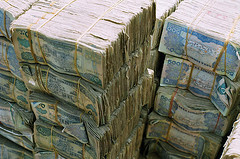East African currencies continue to struggle against the US Dollar
 (The East African) – East African economies are feeling the pinch of inflation as their currencies continues to weaken against the dollar.
(The East African) – East African economies are feeling the pinch of inflation as their currencies continues to weaken against the dollar.
By Allan Olingo
Uganda and Rwanda managed to ensure the inflation rate remained below 5 per cent. Rwanda’s inflation for August was at 0.9 per cent, the region’s lowest, having dropped from July’s 1.9 percentage.
Kenya’s inflation crept up to 8.36 per cent up from 7.67 per cent in July and 7.39 per cent in the previous month, while Tanzania has seen inflation rise by 0.2 per cent to 6.5 per cent in August as compared to 6.3 per cent in July.
Inflation rate in Uganda fell to 2.8 per cent in the year to August from 4.3 per cent in July while core inflation, which excludes prices of food, fuel and utilities, inched up to 3.1 per cent during the same period from three per cent in July.
Aly Khan Satchu, a financial market analyst says that so far the Kenyan shilling has lost 2.2 per cent points to the dollar this year.
“We do not expect the currency to depreciate as much as other currencies within the region but we expect the weakening to hold given the expected increase in currency demands as we approach the tourism season. We have also seen the Central Bank willing to intervene in the market and support the situation if needs be,” says Mr Satchu.
The Kenya National Bureau of Statistics blames the inflation uptick on a 0.50 per cent increase in the food and non-alcoholic drinks index, which accounts for just over a third of the basket of goods used to measure inflation.
Last week, most commercial banks quoted the Kenya shilling at 88.30 to the dollar, down from a close of 88.05 the previous week.
Last month, the Central Bank of Kenya Monetary Policy Committee left the key lending rate unchanged at 8.5 per cent, a move meant to contain accelerating inflation without stifling economic growth.
Uganda on the other side is posting a positive economic outlook with the inflation drop largely being attributed to a reduction in the inflation rate for food crops to 1.5 per cent for the year ending August 2014 from 12.9 per cent for the year ended July.
Bank of Uganda has kept its main lending rate at 11 per cent, noting that inflation was within its target and the economy was on track to grow six per cent in 2014.
Despite the negative inflation, Uganda’s central bank has intervened three times this month to support the shilling. Bank of Uganda started selling dollars in early trade after the shilling dropped to 2,655/2,665, the weakest level since February 2013.
By Friday last week, it had strengthened to 2,650/2,660, where it had closed on Tuesday. The pressure has been attributed to the demand for the dollar by oil companies, importers and the energy companies. The shilling has weakened about 5 per cent against the dollar this year.
Ephraim Kwesigabo, director of the Tanzania National Bureau of Statistics, while releasing the August inflation results indicated that the increase was as a result of demand of non-food items.
Mr Kwesigabo said that month on month inflation rose 0.1 per cent in August, the same rate that it rose in the previous month.
“We have seen food and non-alcoholic beverages inflation rate increase to 8.8 per cent from 8.1 per cent in July. We have also seen an increase in household food to 8.5 per cent from 7.9 per cent recorded last month. Annual inflation rate which excludes food and energy for the month of August slightly decreased to 3.1 per cent from 3.2 per cent in July,” Mr Kwesigabo said.
In April Tanzania Central Bank Governor Prof Benno Ndulu said that the expected increase of food prices in the East Africa region may pose risk to inflation within Tanzania.
“We have managed to keep inflation at single digits during the year due to continued implementation of prudent monetary and fiscal policies. Given projected softening of world oil prices and food prices in the SADC region, single-digit inflation is expected to remain,” Professor Ndulu said.
In Tanzania the shilling is trading at 1,665/1,675 to the dollar which is weaker than the August average of 1,660/1,670.
The weakening of the Tanzanian shilling has been attributed to the easing of the liquidity squeeze on the local currency, which has ushered in a rise of demand for dollars from oil and construction sectors.
The Rwandan franc slightly depreciated by 1.9 per cent against the US dollar due to high demand for foreign exchange to finance imports in the first half of 2014.
“The first half of the year has seen a more less stable exchange rate with a modulate depreciation of 1.9 per cent on the official rate and 2.1 per cent on the market rate. This is linked to an increase in foreign exchange resources to the private sector which increased by 14.8 per cent,” the Governor BNR, John Rwangombwa said.
Photo/Tristam Sparks